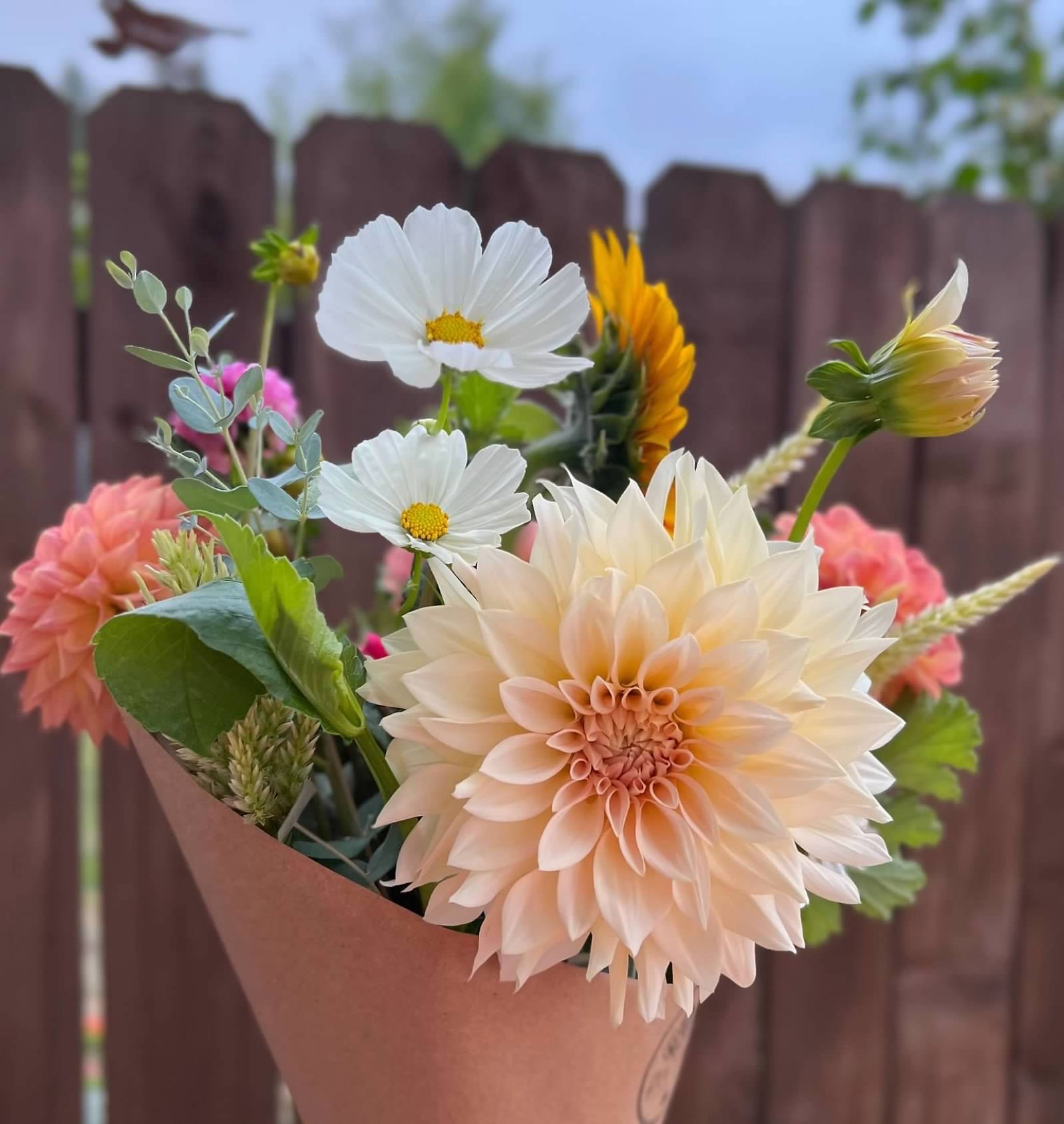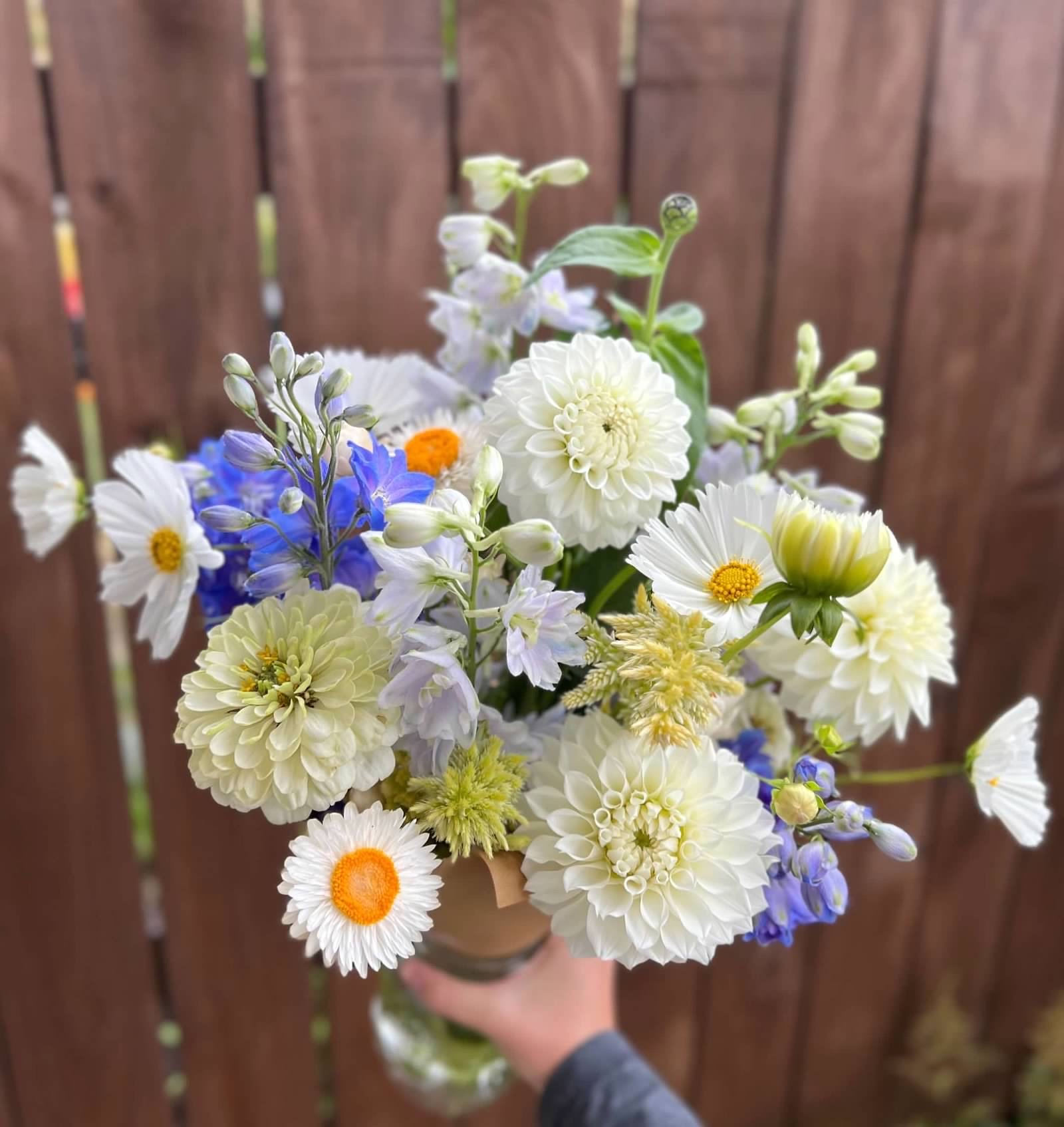Dahlias, Dahlias, DAHLIAS!
If you’ve grown them, you love them.
And if you haven’t, well buckle up for your next obsession!
Hide the credit card! Somehow everyone who has begun growing dahlias can’t seem to get enough of them and will spend whatever they need to in order to get that one variety they’ve suddenly fallen in love with (myself included!)
If you are new to dahlias, I’d love to share some of my successes and more importantly, some of my failures to help you become a pro in no time.
Lesson 1: Soil health is extremely important when growing dahlias. My first year growing a cut flower garden, I started with lifeless and nutritionally off-balanced, sticky, nasty clay soil. Not even worms liked my soil! My dahlias did TERRIBLE! Not only did they grow extremely slowly and give me only a few blooms, they also had every pest known to man feasting on them! Early that year I sent off a soil sample and amended accordingly (along with adding compost) before planting my dahlias. However, soil amendments don’t work immediately. So in that first year, I limped the dahlias along just praying they’d survive and give me a few tubers for the following year (spoiler- they did! So the obsession continued).
Lesson 2: Pests are common and can easily spread disease (which dahlias are known for). Common pests that dahlias face include slugs, aphids, thrips, spider mites, cucumber beetles, japanese beetles, mealybugs, and white flies. I’ve dealt with them all (except for japanese beetles) to varying degrees throughout my 5+ years of growing dahlias seriously.
I’ve tried a variety of pest management solutions and have found good success with organic pest management that focuses on prevention first, the release of predatory insects second, and organic spraying third. In my first year, I sprayed organic sprays mainly to manage my pests. And they worked (for a very little bit). I found in order to keep the pests at bay, I needed to spray weekly. Not only did I not want to devote that much time at dusk or dawn spraying (to minimize the effect on beneficials) every week, I did not feel good about spraying weekly.
My goal since the following year, has been to create a natural predator/pest relationship that has me minimally involved. Personally I’ve landed on this schedule below for the upcoming season (this may or may not work for you, so take this with a grain of salt).
Apply Black Strap Molasses (2T/Gal) twice per month to raise the brix level of my plants (check out Jenny Love of No Till Flowers podcast on brix to learn more). Raising brix levels leads to a plant having a greater pest and disease resistance.
Apply triple threat beneficial nematodes once per month from March-June.
Apply green lacewing eggs once per month from April-August.
Apply minute pirate bugs when I have an outbreak of aphids, thrips, spider mites, mealy bugs or white flies.
Spray Captain Jacks Dead Bug Brew as a last resort if an outbreak gets out of control (I was able to avoid this all of last year with the management listed above).
I purchase my benefical predators from Arbico Organics and Nature’s Good Guys. I do not have any sponsorships with them, I just like them.
This plan is far from the cheapest form of pest management, but it is the method that I feel good about using. I aim to not spray any pesticides as that harms beneficial insects as well as the pests you are targeting. In my research, I have not found any spray that does not harm beneficials at all.
I find that each year I focus on improving my soil health, decreasing my spraying of any pesticides (even organic ones), and releasing predators, my inputs decrease more and more. I am hopeful that this coming year I will primarily utilize molasses, beneficial nematodes, and green lacewing eggs as my pest management/prevention solutions.
Lesson 3: Staking is crucial! I know of quite a few growers who do not stake their plants at all and only have a small percentage fall over. I also know of even more growers who utilize the corralling method with great success. Neither of those have been a successful staking method for me. This past season, I wanted to trial the coralling method since I’m not a huge fan of hortonova netting. If you are unfamiliar with this method, you use tposts as your support around the outside of your rows and baling twine to make a box around the outside of your dahlias and an x through the middle. They will grow up through this and the twine will give them enough support to keep them upright. I trialed this method last year in an area of my hillside and let me tell you, maybe 10% of my plants stayed upright. It was a total fail! I now realize my hillside is too steep for lower degrees of support. I ended up mid season trying to individually stake some and add hortonova netting to others wherever possible. Now I know, it’s hortonova netting for me, which is unfortunate because hortonova netting and I have a love/hate relationship. I love it mid season when it is perfectly holding up my plants, but it’s a bit of a pain when it comes to harvesting stems and I hate untangling and installing it. Don’t get me started on removing it!
Lesson 4: Dial in a watering routine. Dahlias need a decent amount of water throughout the growing season (especially if you live somewhere that does not get a lot of rain in the summer like the PNW). They do not like sitting in really wet soil though. The tubers are prone to rotting if they get too much water. So there’s a delicate balance!
I listened to a podcast from Jenny Love of No Till Flowers on the power of pulse watering this past winter and I am excited to try that method for myself. I plan to change from my previous schedule of long, less frequent watering sessions through my drip system to watering several times per day for a short duration. I’m going to play around with the scheduling of it all this upcoming season, but I think it will be helpful for me in my dry summer climate for my plants to have easy access to water without making them soggy all summer. You should definitely listen to her podcast for more info on pulse watering!
I hope you enjoyed hearing about my experiences growing dahlias and hope you’ll continue following our journey as we excitedly enter this upcoming year! Our Dahlia Tuber Sale is coming up very soon!
Our sale is March 8th at 9am for the general public. If you want early access, sign up for our newsletter and you will get an email receiving the password to shop at 8am!
Please reach out with any questions you may have about growing dahlias. I’d love for these flowers to bring you the intense joy you deserve!
Shelby
Little 3 year old Finn
RM Summer Haze
The Queen of Dahlias (Cafe Au Lait) in a summer bouquet
A fun gender reveal bouquet I got to do featuring Blizzard.
Irish Ruffles. The perfect white with a hint of blush. It is so prolific for being a larger sized bloom!
RM Whirligig. I’m currently in the process of rooting as many cuttings as possible of this beauty. It was one of my favorite new varieties last year!






